Corticosteroids (also referred to just as steroids), are a widely used synthetic hormone, prescribed across many different medical specialties due to their fast-acting nature and their effectiveness in treating inflammation and auto-immune diseases.
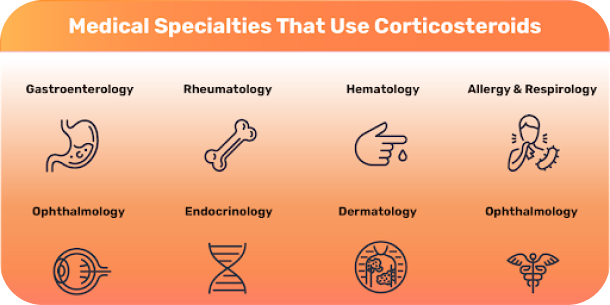
The Four Mechanisms of Corticosteroids
Corticosteroids are:
Corticosteroids are:
- Anti-Inflammatory
- Anti-Proliferative
- Vasoconstrictive
- Immunosuppressive

Corticosteroids act as anti-inflammatory agents, targeting the signal pathway for inflammation, almost like putting a kink in a water hose. Inflammation serves as a vital signal for the body’s response to damage; however, in conditions like eczema, it can spiral out of control. Corticosteroids effectively manage this inflammation by reducing the production of inflammatory signals at the affected site

Anti-proliferative means to slow down the body’s natural production of cells, a property crucial in treating conditions like psoriasis, where there’s an excessive creation of new cells, leading to hard plaques or scaly patches. This property is also beneficial in cancer treatment, where there’s abnormal and rapid cell growth.

Vasoconstriction is the narrowing of blood vessels, primarily by contracting smooth muscle cells in their walls. This narrowing reduces the diameter of the vessels, restricting blood flow. This can be very useful when treating skin conditions because it can reduce swelling and inflammation.

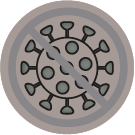
Immunosuppression, used to treat autoimmune diseases and skin conditions, involves stopping overactive immune responses. Eczema, vitiligo, psoriasis, and hidradenitis suppurativa are all thought to be related to immune system dysfunction. In the case of eczema, the immune system is overactive, sending out signals to the skin indicating harm, which leads to inflammation and itching. By stopping this signal, doctors can attempt to gain control of the problem.
Different Types of Corticosteroids
Corticosteroids can be classified into their different potencies, routes of administration, and the duration of action. There are two main types, known as glucocorticoids, and the much less common mineralocorticoids. In dermatology the use of mineralocorticoids is fairly limited, and so most of this discussion is focused on glucocorticoids.
You can be prescribed steroids in the form of a cream, gel, or lotion, known as topical steroid; in tablet form for oral use; via injection; or through an inhaler. The method your doctor prescribes depends on your specific situation. The absorption of corticosteroids can vary by 300 times the difference (or 3000%), depending on which area the medication is applied to. Areas of thin skin such as the eyelid, or genitalia, absorb much easier than thick skin such as the soles of the feet.
We will discuss the implications of each administration route now.
Different Types of Corticosteroids
Corticosteroids can be classified into their different potencies, routes of administration, and the duration of action. There are two main types, known as glucocorticoids, and the much less common mineralocorticoids. In dermatology the use of mineralocorticoids is fairly limited, and so most of this discussion is focused on glucocorticoids.
You can be prescribed corticosteroids in the form of a cream, gel, or lotion, known as topical steroid; in tablet form for oral use; via injection; or through an inhaler. The method your doctor prescribes depends on your specific situation. The absorption of corticosteroids can vary by 300 times the difference (or 3000%), depending on which area the medication is applied to. Areas of thin skin such as the eyelid, or genitalia, absorb much easier than thick skin such as the soles of the feet.
We will discuss the implications of each administration route now.


Topical means applied directly on the skin. Topical corticosteroids can be made in many different forms including: gels, lotions, mousses, tapes or bandages, ointments, or creams. The level of absorption of corticosteroids can vary by 300 times the difference, depending on which area the medication is applied to. Areas of thin skin, such as the eyelid, or genitalia, absorb much easier than a thick area such as the soles of the feet. In the case of thicker skin, a much more potent mixture is prescribed. Age and severity of symptoms also play a significant role in which treatment your doctor will prescribe to you.
Because of the considerable side effects that come with mis-use and long term use of corticosteroids, potency varies from extremely potent to mildly potent, and a doctor’s plan for using them is highly strategic.

Oral corticosteroids are ingested and will affect the entire body. They are prescribed much less often these days, and only in extreme cases.
These are commonly referred to as systemic corticosteroids, because they act on the entire body system. The oral route is usually prescribed in more severe cases when a topical steroid won’t be enough. The dose will be tapered off near the end of treatment to avoid shocking the body, cutting off production of the hormone cortisol.
Oral corticosteroids can either be designed for an immediate or delayed response, and are usually used for a shorter period of time – with a higher potency overall than topicals.
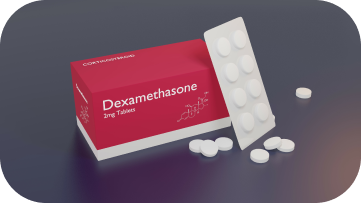

Commonly prescribed for asthma, inhaled corticosteroids work in much the same way as others. They reduce inflammation and manage difficult symptoms quickly.

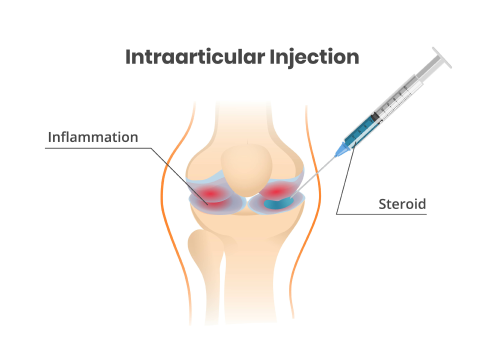
Injecting the treatment allows for precise, targeted delivery of potent steroids for rapid relief of symptoms with minimal systemic (all through the body) exposure. This is good because corticosteroids have side effects when too much is exposed to the body and injecting allows for much greater control.
This method is often used for plaque psoriasis, localized eczema, or alopecia areata.
To minimize the risk of adverse effects, we follow proper injection techniques, limit the amount of injections, and carefully monitor our patients for any side effects.

Injecting the treatment allows for precise, targeted delivery of potent steroids for rapid relief of symptoms with minimal systemic (all through the body) exposure. This is good because corticosteroids have side effects when too much is exposed to the body and injecting allows for much greater control.
This method is often used for plaque psoriasis, localized eczema, or alopecia areata.
To minimize the risk of adverse effects, we follow proper injection techniques, limit the amount of injections, and carefully monitor our patients for any side effects.

Use In Treating Skin Diseases
Basics of Using Topical Steroids
It’s important to take breaks from the use of steroids, to learn more about why, see the side effects section of this article. Follow the recommendations of your dermatologist closely as they are critical to the best possible outcomes.
Every plan to use corticosteroids on eczema should be tailored to the individual. Age, severity of condition, area of treatment (groin, eyelids, etc.), skin type, and the size of the area to be treated, all come into play.
Patients should also be mindful of their triggers. While corticosteroids do work effectively in many situations, managing triggers for eczema flare-ups can go a long way in avoiding the cycle of the broken skin barrier.
It is often recommended to use emollients in combination with topical steroids. Emollients are just a moisturizer; which is common practice in treating eczema. Keeping skin moisturized goes a long way to maintaining the thin layer of oil on the surface of the skin, which can protect against eczema flare ups. Emollients should be applied at least half an hour after applying topical steroids to avoid mixing and dilution of the treatment. Ask your dermatologist about the details for using emollients in your treatment plan.
There is a right way to apply topical steroids. If possible, apply with clean hands to clean, slightly moist skin. A good time for application is after bathing or showering.
Fingertip Unit of Measurement
Proper measurement of the treatment is important. Too little can cause the treatment plan to be ineffective, while too much can bring on side effects. The standard for measurement is called a Fingertip Unit, and it is the distance from an adult’s index fingertip to the first crease in the finger (just above the first knuckle). One fingertip unit is typically used to cover a skin area of one adult palm with the fingers together. Your doctor will advise you on proper measurement for your specific needs.
In more severe cases of eczema, doctors may prescribe oral or injected corticosteroids. Oral administration acts on the entire body, and is often a stronger dose prescribed for a shorter period of time. Injected corticosteroids are effective at treating localized problem areas. If corticosteroids do not manage symptoms effectively, there are many different options for treatment. Researchers are working on developing more effective treatments right now through clinical trials. Some alternative treatments for eczema include: light-therapy, calcineurin inhibitors, systemic immunomodulators, biologic therapies, or allergen immunotherapy. If you’re reading this now, we haven’t quite gotten to our educational sections on these treatments, but it is on the way!
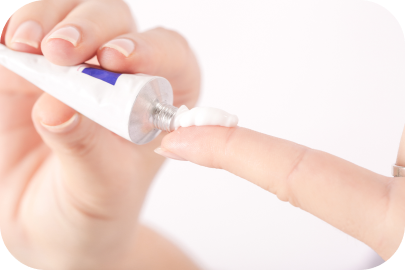
One Fingertip Unit

Corticosteroids are a common and effective way to treat many cases of eczema. It’s important to follow all instructions that your skin care provider gives you, as a careful balance is required to avoid side-effects. For moderate cases of eczema dermatologists will often prescribe topical (applied to the skin) solutions like creams, gels, lotions, ointments, or shampoos. These treatments are highly effective in most cases.
Part of the difficulty with eczema is that once the layer of oil on the skin is broken, the skin is more exposed to irritants that can trigger more symptoms. Corticosteroids can help reduce the irritation long enough for the skin barrier to return, effectively breaking the cycle in many cases. Topicals are typically recommended for short term use, often between one to two weeks. The main goal is to control a flare-up of symptoms and then stop use, possibly with a plan of intermittent application.
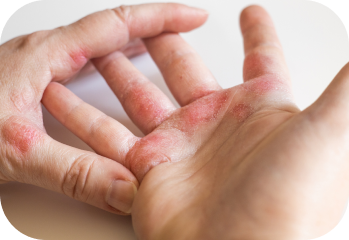

Corticosteroids are a common and effective way to treat many cases of eczema. It’s important to follow all instructions that your skin care provider gives you, as a careful balance is required to avoid side-effects. For moderate cases of eczema dermatologists will often prescribe topical (applied to the skin) solutions like creams, gels, lotions, ointments, or shampoos. These treatments are highly effective in most cases.
Part of the difficulty with eczema is that once the layer of oil on the skin is broken, the skin is more exposed to irritants that can trigger more symptoms. Corticosteroids can help reduce the irritation long enough for the skin barrier to return, effectively breaking the cycle in many cases. Topicals are typically recommended for short term use, often between one to two weeks. The main goal is to control a flare-up of symptoms and then stop use, possibly with a plan of intermittent application.
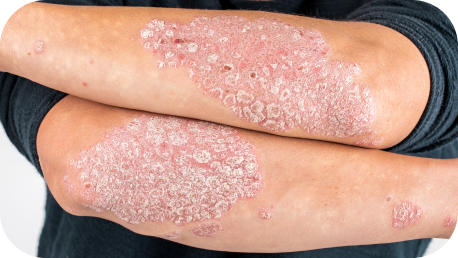
There is a right way to apply topical steroids. If possible, apply with clean hands to clean, slightly moist skin. A good time for application is after bathing or showering.
Proper measurement of the treatment is important. Too little can cause the treatment plan to be ineffective, while too much can bring on side effects. The standard for measurement is called a Fingertip Unit, and it is the distance from an adult’s index fingertip to the first crease in the finger (just above the first knuckle). One fingertip unit is typically used to cover a skin area of one adult palm with the fingers together. Your doctor will advise you on proper measurement for your specific needs.

Corticosteroids are also commonly used to treat contact dermatitis, seborrheic dermatitis, pruritus, cutaneous lupus erythematosus, lichen planus, dermatitis herpetiformis, bullous phemigoid, granuloma annulare, and prurigo nodularis.
Side Effects
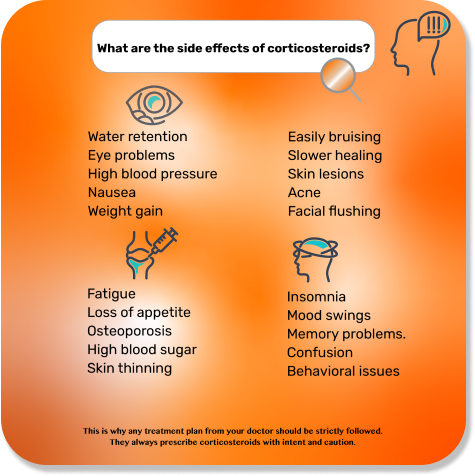
Despite their effectiveness and widespread use, misuse of corticosteroids does come with side effects. Doctors carefully weigh the risks and benefits with consideration of age, health, and more when they develop a treatment plan for you. Side-effects can usually be avoided through proper planning and are generally the result of too much medication for too long.
Potential side-effects include:
Increased water retention – swelling, swelling in lower legs, round face.
Eye problems – glaucoma, or cataracts.
High blood pressure.
Nausea.
Weight gain (typically lower back, belly, or face).
Fatigue.
Loss of appetite.
Osteoporosis (thinning and weakening of bones).
High blood sugar.
Skin thinning.
Easily bruising.
Slower healing.
Skin lesions.
Acne.
Facial flushing
Insomnia
Mood swings.
Memory problems.
Psychological disturbances (confusion, behavior changes).
While the side-effects can be serious, they can often be avoided.
History
Research on corticosteroids officially began in the 1930s. Part of the reasoning behind the research (besides the interest of the medical community) was because it was rumored that German pilots were using what is now known as cortisone to improve their flying abilities.
Cortisone was originally discovered in the 1920s when the hormone was isolated through animal research at the Mayo Clinic. Research was initially limited to just mice, and the bulk of the work did not begin until a partnership was formed with Merck & Co to synthesize lab made versions of the hormone. Cortisone was later found to have effects on muscular activation, resistance to cold, stress, and toxic materials.
Because of the early research, several clinical studies were conducted where cortisone’s sister hormone, cortisol, was injected into the joints of arthritic patients. The effects were temporary, and researchers were cautionate to say that it was not a cure, but it helped reduce pain and restore function in most cases. In 1950 the researchers that discovered cortisol (Philip Hench, Edward Kendall, and Tadeus Reichstein) were awarded the Nobel Prize in medicine and physiology.
References
https://pubmed.ncbi.nlm.nih.gov/25556056/https://www.mayoclinic.org/steroids/art-20045692
https://my.clevelandclinic.org/health/drugs/4812-corticosteroids
https://www.ncbi.nlm.nih.gov/pmc/articles/PMC1751559/#:~:text=Corticosteroids%20exert%20their%20anti%2Dinflammatory,the%20inflammatory%20gene%20transcriptional%20complex.
https://pubmed.ncbi.nlm.nih.gov/25556056/
https://www.uptodate.com/contents/topical-corticosteroids-use-and-adverse-effects
https://www.medicalnewstoday.com/articles/corticosteroids#useshttps://my.clevelandclinic.org/health/body/22983-adrenal-cortex
https://www.ncbi.nlm.nih.gov/books/NBK532940/https://www.aad.org/public/diseases/psoriasis/treatment/medications/corticosteroids#:~:text=If%20you%20have%20mild%20or,quickly%20your%20skin%20cells%20grow
https://www.aafp.org/pubs/afp/issues/1999/0215/p957.html
https://www.verywellhealth.com/psoriasis-best-topical-steroid-creams-2788375
https://www.ncbi.nlm.nih.gov/books/NBK531462/#:~:text=%5B13%5D%20These%20adverse%20effects%20include,of%20hair%2C%20and%20perioral%20dermatitis.&text=Glucocorticoids%20increase%20the%20risk%20of,ulcer%20formation%2C%20and%20GI%20bleeding.
https://www.mayoclinic.org/steroids/art-20045692
https://www.nhsinform.scot/tests-and-treatments/medicines-and-medical-aids/types-of-medicine/corticosteroids/
https://www.painphysicianjournal.com/current/pdf?article=NzIwNw%3D%3D&journal=133
https://pubmed.ncbi.nlm.nih.gov/22018177/#:~:text=Oral%20and%20intra%2Darticular%20administration,for%20systemic%20anti%2Dimflammatory%20therapy.
SimcoDerm is a full service, comprehensive dermatology clinic located in Barrie. We provide our services to all the patients in Simcoe County and beyond.
Latest Tweets
Contact
- 105-5 Quarry Ridge Rd. Barrie, On, L4M 7G1
- Tel: (705) 503-6333
© 2024 SimcoDerm

